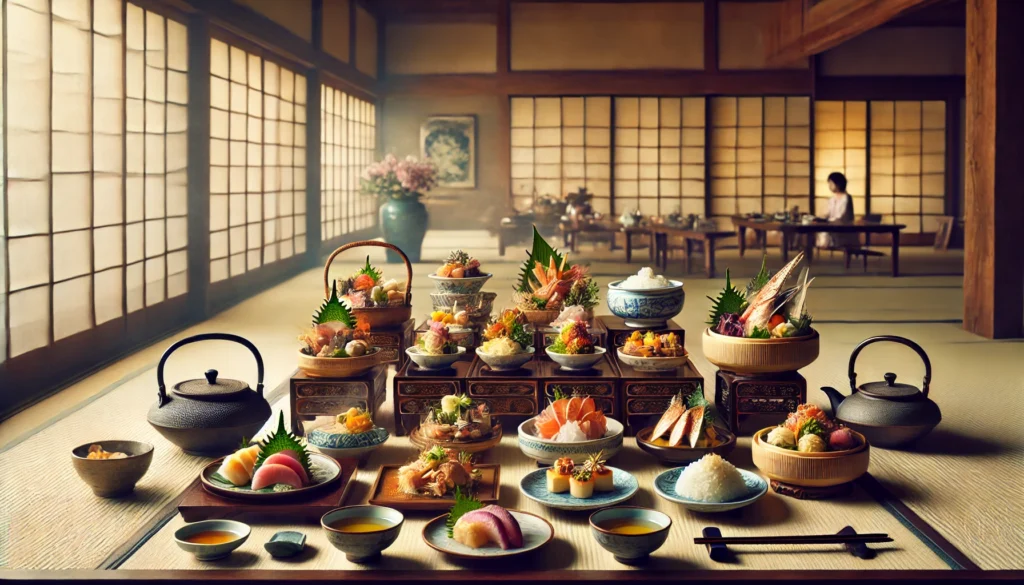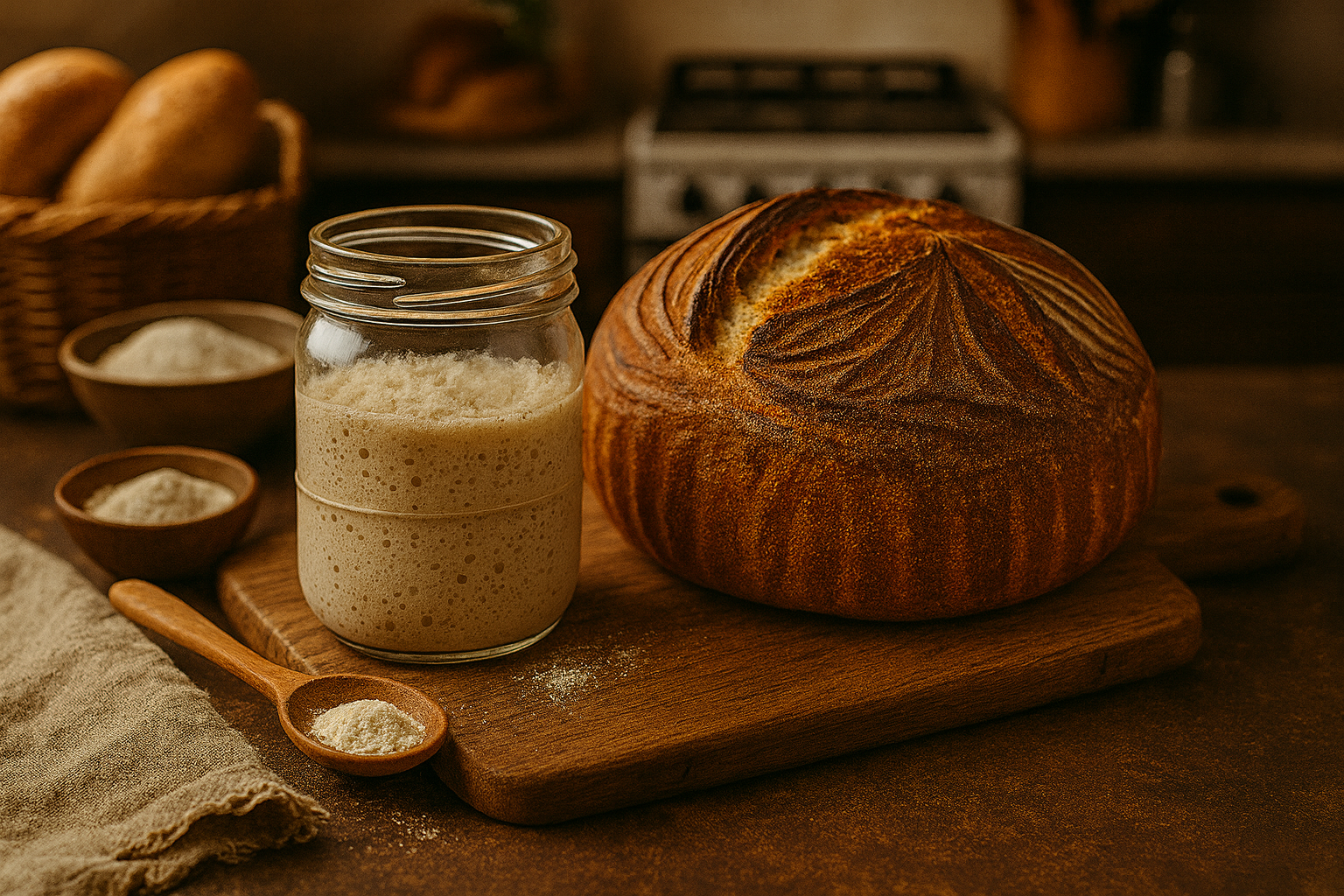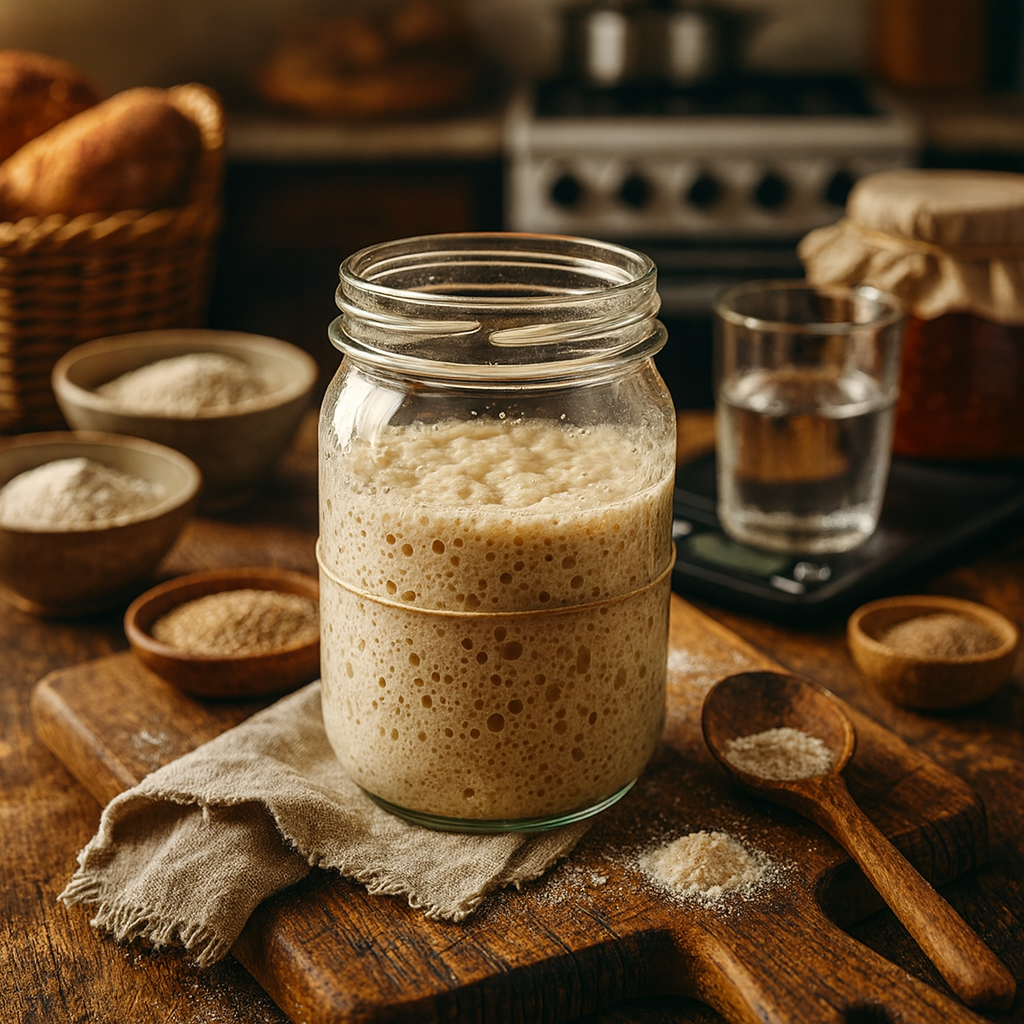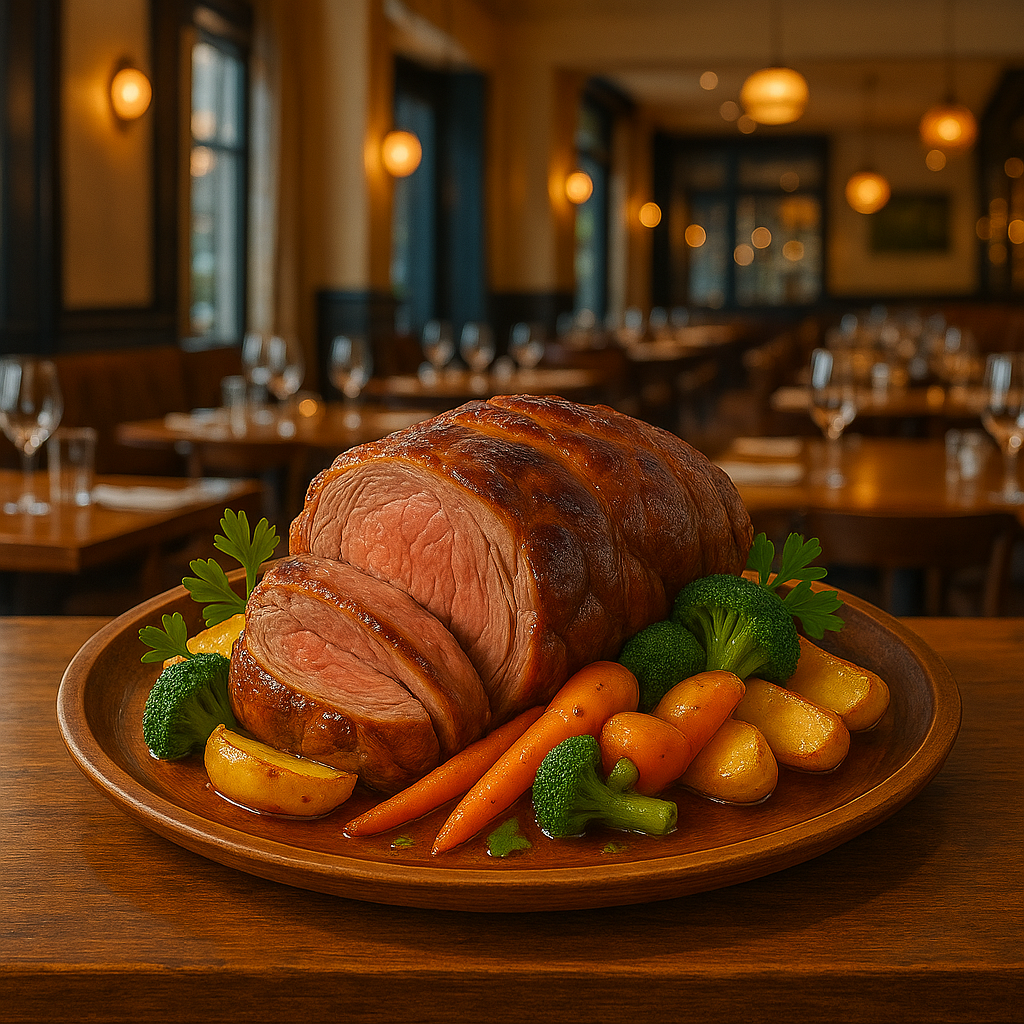Table of Contents
Introduction to Kaiseki
Kaiseki is a traditional Japanese dining experience that embodies the rich culture and culinary artistry of Japan. Originating in the sixteenth century during the Japanese tea ceremony, the concept of Kaiseki has evolved significantly over the years. Initially, it comprised simple dishes served to accompany tea, but it gradually transformed into a multi-course meal that highlights seasonal ingredients and exquisite presentation. This evolution of Kaiseki underscores its significance not just as food but as an art form central to Japanese culture.
The core philosophy behind Kaiseki revolves around the idea of harmony; every element from the colors to the textures is carefully chosen to create a balanced dining experience. Typically, a Kaiseki meal consists of several courses, each presenting a unique dish that reflects the ingredients’ freshness and flavor profile. These courses range from appetizers to soups, main dishes, and desserts, all intended to delight the senses. The composition of the meal often changes with the seasons, celebrating the natural beauty and bounty of each time of year.
Moreover, Kaiseki dining is steeped in ritual and etiquette. The presentation of each dish is considered as important as the taste. Chefs, or “itamae,” spend years honing their craft, preparing not just food but a visual feast that engages diners. The beauty of the tableware, the arrangement of food, and even the selection of seasonal decorations all contribute to creating a holistic experience. This meticulous attention to detail reflects deeper cultural values, emphasizing mindfulness, appreciation for nature, and the significance of sharing meals with others. Through its intricate flavors and artistic expression, Kaiseki represents a profound journey into Japan’s culinary heritage.

The Philosophy Behind Kaiseki
Kaiseki dining is an intricate culinary art form that transcends mere sustenance, embodying a philosophy deeply rooted in Japan’s cultural and natural landscape. At its core, Kaiseki is about achieving balance and harmony, principles that resonate throughout Japanese aesthetics and life. Each course meticulously prepared reflects an awareness of the seasons, ingredients, and preparation methods, emphasizing the significance of using fresh, local produce that showcases nature’s bounty.
This intentional selection of ingredients is intertwined with the ethos of ‘wabi-sabi,’ which appreciates the beauty found in imperfection and transience. The aesthetic values of ‘wabi-sabi’ are manifest in Kaiseki dining through the careful presentation of each dish, where simplicity and subtle elegance fuse seamlessly to create a visual feast. The presentation is not just about aesthetics; it invites the diner to recognize the nature of the ingredients, the effort of the chef, and the fleeting essence of each season.
Furthermore, Kaiseki enhances the dining experience by emphasizing the connection between food, nature, and the diner’s emotions. As each dish unfolds, it tells a story, often reflecting personal and cultural values, encouraging diners to appreciate the moment—a core tenet in Japanese culture. The meticulously curated sequence of courses offers an organized narrative that allows individuals to savor and reflect on their surroundings, both in terms of flavors and ambiance.
This mindful approach cultivates a sense of respect for the ingredients and the earth, encouraging diners not only to feast but to engage in a profound experience that reinforces the relationship between cuisine and nature. Ultimately, Kaiseki stands as a reflection of Japanese ideals, marrying culinary artistry with deeper philosophical concepts that resonate throughout the dining experience.
The Structure of a Kaiseki Meal
Kaiseki dining is an intricate culinary experience that often reflects the seasons and regions of Japan. The traditional structure of a Kaiseki meal typically encompasses multiple courses, each serving a distinct purpose in presenting the meal’s aesthetic and flavor profile. The essential components of a Kaiseki meal can vary by chef and season, but several key sections define the experience.
The first course, known as ‘sakizuke,’ usually consists of a small appetizer that sets the tone for the meal. This dish is crafted to stimulate the palate and often incorporates fresh, seasonal ingredients. Following sakizuke, diners will encounter ‘mukozuke,’ which is often sashimi, showcasing the chef’s knife skills and the quality of fresh fish available. The beauty of this dish lies not only in its taste but also in the presentation, which reflects the artistry of Japanese culture.
As the meal progresses, ‘naka-choko’ serves as a refreshing intermezzo, typically a light sorbet or broth that cleanses the palate. This course is crucial in bridging the gap between heavier courses and enhancing the overall dining experience. The main dish, referred to as ‘ryori,’ is where the meal truly comes to life, comprising a variety of protein options, often served with accompaniments that resonate with seasonal flavors. The final courses may include grilled items (‘yakimono’) and simmered dishes (‘nimono’), which are crafted to warm the soul while embodying the essence of Japanese cooking.
Each component of a Kaiseki meal is meticulously chosen and arranged, ensuring that the entire dining experience remains balanced and harmonious. This careful attention to detail illustrates the philosophy of Kaiseki, where each course plays a significant role in creating a memorable culinary journey.
Seasonality and Ingredients
Kaiseki cuisine is deeply rooted in the principles of seasonality and locality, reflecting Japan’s varied climate and abundant natural resources. This traditional multi-course dining experience emphasizes fresh, high-quality ingredients that are in harmony with the seasons. Each course in a Kaiseki meal is crafted to highlight the best produce available during that specific time of year, ensuring that every dish is not only flavorful but also visually appealing.
The selection of seasonal ingredients is a fundamental aspect of Kaiseki. For instance, spring might feature delicacies such as fresh bamboo shoots, cherry blossoms, and yuba (tofu skin), while summer may present the vibrant colors of cucumbers and eggplants. In autumn, hearty flavors often come to the forefront, highlighted by ingredients like chestnuts and persimmons. Winter, in turn, showcases ingredients like root vegetables and snow-crab, which are celebrated for their robust flavors and textures. This cyclical approach to ingredient selection underscores the significance of nature in Japanese culture.
Moreover, the focus on local produce is paramount in Kaiseki. Chefs often source ingredients from nearby farms and fisheries, reinforcing a sense of community and sustainability. This connection to the land not only supports local economies but also enhances the quality of the dishes, as freshly harvested ingredients tend to offer superior flavor and nutritional value. The use of carefully selected ingredients reflects a mindfulness and respect towards nature, evident in every meticulously prepared course.
Incorporating the essence of each season, Kaiseki cuisine instills a deep appreciation for the natural world. This cuisine goes beyond mere nourishment; it is a celebration of the beauty and diversity of Japan’s culinary landscape, perpetually changing with the seasons, thus creating a unique gastronomic journey for each diner.
The Art of Presentation
Kaiseki, as a refined culinary tradition from Japan, is not only celebrated for its exquisite flavors but also for its remarkable visual presentation. The artistry involved in plating and presentation of Kaiseki dishes plays a pivotal role in enhancing the overall dining experience, engaging all the senses of the guest. Each course is meticulously crafted, embodying a profound respect for aesthetics and seasonal ingredients. This commitment to presentation transforms the meal into an artistic expression.
The techniques employed by chefs in Kaiseki are diverse and deliberate. Foremost in these techniques is the use of color. Chefs carefully choose seasonal ingredients with vibrant hues, ensuring that each dish embodies a balance of colors reminiscent of nature. The arrangement of these elements is equally critical; food is often artfully laid out in a way that encourages the diner to appreciate the harmony and contrast present on the plate. This meticulous arrangement reinforces the visual appeal of the meal and highlights the care taken in preparation.
Tableware selection further amplifies the artistry of Kaiseki. Traditional vessels, made from materials like ceramic, lacquer, or wood, contribute significantly to the overall aesthetic. These pieces are often selected to complement the dish, enhancing the colors and textures while drawing attention to seasonal themes. Notably, the shape and size of the tableware are also pivotal in creating a balanced presentation, ensuring each component is highlighted appropriately.
In essence, the presentation of Kaiseki serves as a multisensory experience that extends beyond the palate. It engages the eyes and invites a deeper appreciation of the culinary skill and artistry that shapes each course. As diners savor the flavors, they are simultaneously treated to a feast for the eyes, reinforcing the idea that great food encompasses much more than taste alone.
Experiencing Kaiseki: Where to Dine
Kaiseki dining, celebrated for its meticulous presentation and seasonal ingredients, can be experienced in numerous dining establishments throughout Japan. Both urban and rural settings offer unique opportunities to appreciate this culinary art form. In metropolitan areas such as Kyoto and Tokyo, some of the most renowned Kaiseki restaurants provide not only exquisite meals but also remarkable atmospheres. For instance, Kikunoi Honten in Kyoto is an outstanding choice, well-regarded for its authentic approach to Kaiseki cuisine and its commitment to sustainability. With a reputation built on a history of excellence, the restaurant showcases dishes that reflect the changing seasons, making each visit a new adventure for the palate.
In Tokyo, a visit to Ishikawa is recommended for those seeking a high-end Kaiseki experience. Chef Ishikawa meticulously prepares each course, often incorporating rare ingredients from local farmers and fishermen. The restaurant’s intimate setting and direct interaction with the chef enhance the dining experience, offering patrons a unique insight into the artistry behind each dish.
Meanwhile, rural areas present their own charms and culinary experiences. One such establishment is Gion Hanasaki in Kyoto’s historic Gion district, where traditional wooden architecture complements the elegant presentation of each course. Here, guests can enjoy meals crafted from ingredients sourced from the surrounding countryside. This connection to regional farming and fishing highlights the beauty of local cuisine, making the experience truly authentic.
Additionally, those exploring the countryside should not miss out on the scenic beauty and culinary delights found in Nara, where restaurants like Kasuga are known for their serene settings and farm-to-table approach. Culinary enthusiasts often journey to these remote areas to savor a Kaiseki meal that reflects not just the food but the essence of Japanese culture and hospitality. Each recommended venue offers a unique perspective on this traditional dining experience, ensuring that every meal is a journey through the flavors and textures of Japan.
Kaiseki Beyond the Table
Kaiseki is not merely a culinary experience; it encompasses a rich cultural tapestry that extends far beyond the dining table. This traditional multi-course meal, with its origins rooted in the Japanese tea ceremony, serves as a profound reflection of Japanese hospitality and artistic expression. It champions the philosophy of valuing seasonal ingredients, meticulous presentation, and the harmony of flavors, which have influenced a multitude of cultural practices throughout Japan.
One of the most notable cultural expressions inspired by Kaiseki is the intricate Japanese tea ceremony. The tea ceremony, or “chanoyu,” embodies a philosophy of mindfulness and simplicity, paralleling the aesthetics of Kaiseki dining. In both practices, the emphasis is placed on the preparation and presentation, encouraging participants to appreciate the moment and the sensory experiences presented to them. This alignment highlights the deep respect for nature and tradition that defines Japanese culture.
Moreover, Kaiseki’s influence can be seen during traditional Japanese festivals, where seasonal ingredients and artisanal crafts come together to celebrate local customs. During such events, the principles of Kaiseki are often showcased through elaborate displays of food that honor the changing seasons, presenting a feast for both the eyes and the palate. These connections illuminate how Kaiseki transcends a mere meal, inviting patrons to engage with Japan’s rich heritage and its evolving narrative.
The essence of Kaiseki extends into various forms of art, including ceramics, calligraphy, and flower arranging, where the careful attention to detail seen in a Kaiseki meal is mirrored. Thus, the philosophy surrounding Kaiseki reveals a holistic approach to life that values beauty, harmony, and respect for nature, establishing it not just as a dining experience, but as a vital component of Japanese culture as a whole.
A Modern Take on Kaiseki
In recent years, the traditional Japanese dining experience of Kaiseki has seen a remarkable evolution as modern chefs seek to reinterpret its age-old principles. While rooted in the meticulous and seasonal nature of classical Kaiseki, contemporary chefs are infusing new life into the practice by blending traditional techniques with innovative culinary trends. This fusion has attracted a new generation of diners eager to explore a multi-course meal that pays homage to Japan’s rich culinary heritage while simultaneously embracing global influences.
One of the key aspects of modern Kaiseki is the incorporation of international flavors and ingredients. Chefs are experimenting with elements from various global cuisines, resulting in diverse and exciting dishes that maintain the essence of Kaiseki. For instance, the use of herbs like cilantro or spices such as cumin—often reserved for non-Japanese dishes—are thoughtfully integrated into the presentation. This not only enhances the flavor profiles but also creates striking visual contrasts that captivate the diner’s attention.
Furthermore, innovative cooking methods are transforming the way Kaiseki is presented. Sous-vide techniques, molecular gastronomy, and the use of modernist cooking equipment allow chefs to create textures and flavors previously unimaginable within traditional frameworks. While these methods are avant-garde, the underlying philosophy remains steadfast: the focus on seasonal ingredients, the balance of flavors, and the aesthetic presentation of each course remain at the forefront. Through these adaptations, modern Kaiseki provides an engaging dining experience that respects its past while forging a new path for the future.
Ultimately, as contemporary chefs redefine Kaiseki, they continue to invite diners to appreciate the artistry and philosophy of this beloved culinary tradition, ensuring its relevance in today’s diverse gastronomy landscape.
Conclusion: The Legacy of Kaiseki
Kaiseki dining represents more than just a meal; it is a profound expression of Japanese culture and aesthetics that has evolved over centuries. Rooted in Zen Buddhist philosophy, this culinary tradition emphasizes harmony, seasonality, and meticulous presentation, reflecting the natural beauty of the environment. Each course in a Kaiseki meal is carefully curated to not only tantalize the palate but also to impart a sense of place and time, showcasing ingredients that are locally sourced and in season. This practice reinforces a deep appreciation for nature and its cycles, a core value in Japanese culture.
The legacy of Kaiseki extends beyond its exquisite flavors; it embraces the art of preparation, serving, and consumption, creating a multi-sensory experience. Chefs dedicate years to mastering the skills required for this intricate form of dining, where presentation is as important as taste. Furthermore, the use of fine ceramics, lacquerware, and seasonal decorations further elevates the dining experience, transforming a meal into an art form. As such, dining in a Kaiseki setting provides an immersive journey that reveals not just the culinary techniques but also the philosophical underpinnings of Japanese society.
Understanding and appreciating Kaiseki is essential for anyone wishing to gain deeper insights into Japanese culture. It serves as a gateway to exploring the values of mindfulness, simplicity, and respect for nature that are woven into the very fabric of life in Japan. As this tradition continues to garner global recognition, it remains an irreplaceable part of Japan’s cultural heritage, inviting both locals and visitors alike to partake in an experience that nourishes the body and soul. Embracing Kaiseki dining enriches one’s appreciation of Japan, offering access to the intricate tapestry of its history and art, making every meal not just nourishing but also enlightening.






